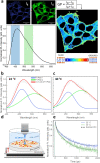Shedding Light on Thermally Induced Optocapacitance at the Organic Biointerface
- PMID: 34524830
- PMCID: PMC8488932
- DOI: 10.1021/acs.jpcb.1c06054
Shedding Light on Thermally Induced Optocapacitance at the Organic Biointerface
Abstract
Photothermal perturbation of the cell membrane is typically achieved using transducers that convert light into thermal energy, eventually heating the cell membrane. In turn, this leads to the modulation of the membrane electrical capacitance that is assigned to a geometrical modification of the membrane structure. However, the nature of such a change is not understood. In this work, we employ an all-optical spectroscopic approach, based on the use of fluorescent probes, to monitor the membrane polarity, viscosity, and order directly in living cells under thermal excitation transduced by a photoexcited polymer film. We report two major results. First, we show that rising temperature does not just change the geometry of the membrane but indeed it affects the membrane dielectric characteristics by water penetration. Second, we find an additional effect, which is peculiar for the photoexcited semiconducting polymer film, that contributes to the system perturbation and that we tentatively assigned to the photoinduced polarization of the polymer interface.
Conflict of interest statement
The authors declare no competing financial interest.
Figures




References
-
- Manfredi G.; Lodola F.; Paternó G. M.; Vurro V.; Baldelli P.; Benfenati F.; Lanzani G. The Physics of Plasma Membrane Photostimulation. APL Mater. 2021, 9, 03090110.1063/5.0037109. - DOI
-
- Paternò G. M.; Colombo E.; Vurro V.; Lodola F.; Cimò S.; Sesti V.; Molotokaite E.; Bramini M.; Ganzer L.; Fazzi D.; D’Andrea C.; Benfenati F.; Bertarelli C.; Lanzani G. Membrane Environment Enables Ultrafast Isomerization of Amphiphilic Azobenzene. Adv. Sci. 2020, 7, 190324110.1002/advs.201903241. - DOI - PMC - PubMed
Publication types
MeSH terms
Substances
LinkOut - more resources
Full Text Sources

